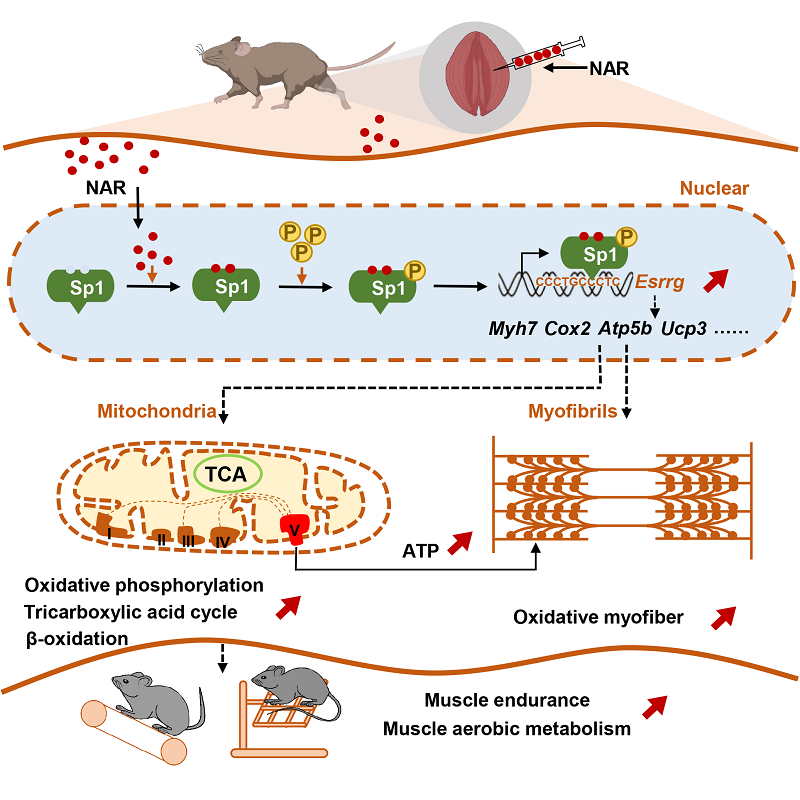The group of Prof. CHEN Chang and collaborators revealed the new function of naringenin in enhancing muscle endurance and improving muscle atrophy by activating Sp1-ERRγ transcription axis
Skeletal muscle plays an extremely important role in supporting movement and energy metabolism. However, its function can be impaired by aging and muscle-related diseases, resulting in decreased endurance or strength of skeletal muscle. Skeletal muscle function decreases with the increase of age or the development of disease. After the age of 30, muscle mass decreases by about 3-8% every decade. Duchenne muscular dystrophy (DMD) is a common muscular dystrophy in children. Children with Duchenne muscular dystrophy completely lose their ability to walk at the age of 7-12, and eventually die due to the degeneration and atrophy of skeletal muscle and myocardium. Therefore, healthy skeletal muscle is very important to the body, and muscle injury greatly affects health and quality of life. However, so far, skeletal muscle is still one of the least adequately treated organs with drugs.
Recently, Prof. CHEN Chang at Institute of Biophysics, Chinese Academy of Sciences, Prof. YE Yang and the group of Prof. CHEN Kaixian at Shanghai Institute of Materia Medica, Chinese Academy of Sciences, have collaborated on research revealing the new function of naringenin to enhance muscle endurance and improve muscle atrophy by activating Sp1-ERRγ transcriptional axis. The relevant research results are published online inCell Reports.
Previous studies by Chen Chang's research group found that Lycium barbarum could improve muscle endurance by increasing oxidative myofiber content and aerobic metabolism, and naringenin (NAR) played a significant role in determining its active components. NAR is a natural plant-derived dihydroflavonoid that has shown effects in metabolic syndrome, inflammation, cancer, and nervous system diseases. However, up to now, the direct target of NAR is still unknown, which greatly limits the functional research and application of NAR. Using 2-month-old young mice, 10-month-old middle-aged mice and mdx mice (DMD disease mice) as models, the researchers found that NAR improved muscle endurance by increasing oxidative myofiber content and aerobic metabolism. Importantly, during the critical period when the muscle function of middle-aged mice (10 months old) begins to decline, NAR can simultaneously increase skeletal muscle mass and endurance. In the mdx muscle disease model mice, NAR significantly alleviated muscle damage both morphologically and functionally, suggesting its crucial role in alleviating age-related or disease-associated muscle atrophy. How does NAR play a role in skeletal muscle? Through affinity pull-down assays using biotin-labeled naringenin (NAR-biotin), mass spectrometry identification and drug design analysis, the researchers found that the GLN-110 site of transcription factor Sp1 can interact with NAR via hydrogen bond. Sp1-AAV and Sp1 inhibitor Mit-A could block the endurance-enhancing effect of NAR in mice. At the same time, the researchers found that NAR could significantly up-regulate the expression of transcription factorEsrrgin the above three animal models and cells, and the inhibition ofEsrrgcould block the effect of NAR on oxidative myofiber content. To further determine the molecular mechanism behind the binding of NAR to Sp1 and regulating the expression ofEsrrg, researchers used mutation assays, truncation experiments, inhibition of binding sites, and chromatin immunoprecipitation. They demonstrated that NAR elevates the phosphorylation level of Sp1, enhancing its binding to theEsrrgpromoter sequence, thereby upregulatingEsrrgexpression to bolster muscle function (Figure 1).
This study found that NAR has a new function in improving skeletal muscle quality and endurance, which has potential significance in preventing muscle atrophy caused by aging or disease. At present, Duchenne muscular dystrophy is mainly treated with gene therapy using oligonucleotides, and this study also provides new ideas on alleviating muscle atrophy caused by Duchenne muscular dystrophy. Secondly, this study also found that the direct target of NAR is Sp1, and revealed the molecular mechanism of NAR on skeletal muscle, which laid a theoretical foundation for the application of NAR. Additionally, the determination of Sp1-ERRγ transcription axis reveals the mechanism by which NAR regulate muscle function, which provides a new idea for drug screening for improving skeletal muscle dysfunction.
Prof. CHEN Chang of Institute of Biophysics, Chinese Academy of Sciences, Prof. YE Yang and Prof. LUO Xiaomin of Shanghai Institute of Materia Medica, Chinese Academy of Sciences, are co-correspondent authors of this paper. LV Zhenyu, a Ph.D. student, Meng Jiao, an associate researcher, Prof. Yao Sheng, a researcher of YE Yang`s group, and Xiao Fu, a Ph.D. student of CHEN Kaixian`s group, are the co-first authors of this article. Academician CHEN Kaixian has provided significant guidance and assistance in protein target prediction.
This project was supported by Strategic Priority Research Program of the Chinese Academy of Sciences (Class B), National Key R&D Program of China, Ningxia Key Research and Development Program Grant, Regional Key Projects of Science and Technology Service Network Plan (STS Plan) of Chinese Academy of Sciences, and the Key-Area Research and Development Program of Guangdong Province.

Figure 1. Naringenin improves muscle endurance via activation of the Sp1-ERRγ transcriptional axis
Article link:https://www.cell.com/cell-reports/fulltext/S2211-1247(23)01300-1
Contact: CHEN Chang
Institute of Biophysics, Chinese Academy of Sciences
Beijing 100101, China
Email: changchen@ibp.ac.cn
(Reported by Prof. CHEN Chang's group)

